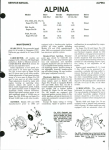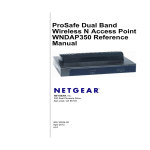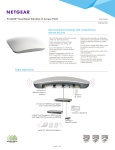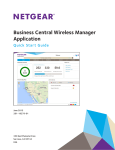Download Netgear WNDAP350 Installation Guide
Transcript
WNDAP350_IGfinal_05Aug09.fm Page 1 Wednesday, August 5, 2009 3:58 PM Connect an Ethernet cable from the WNDAP350 to the PC (point A in the illustration). c. Securely insert the other end of the cable into the WNDAP350 Ethernet port (point B in the illustration). Ethernet Connect the power adapter to the port WNDAP350 and verify the following: • Power/Test. The Power/Test WNDAP350 light blinks when the WNDAP350 is first turned on. After a few seconds it should stay lit (steady green). If after 30 seconds the Power/Test light is not lit or is still blinking, check the connections and check to see if the power outlet is controlled by a wall switch that is turned off. • LAN. There are two LAN LEDs. The 10/100/1000 LED indicates LAN speeds, green for 1000 Mbps, amber for 100Mbps, and no light for 10Mbps. The LINK/ACT LED blinks if there is activity and is off when there is no activity. • WLAN. The 2.4 GHz and 5.0 GHz indicators should be lit or blinking. )NSTALLATION'UIDE ProSafe Dual Band Wireless-N Access Point WNDAP350 TagTTagline Start Here d. Follow these instructions to set up your wireless PC card. Before proceeding with the WNDAP350 installation, familiarize yourself with the contents of the Resource CD. Please refer to the Reference Manual on your Resource CD for instructions on advanced configuration options. Estimated Completion Time: 30 minutes. Tip: Before mounting the WNDAP350 in a high location, first set up and test the WNDAP350 to verify wireless network connectivity. First, Verify the Package Contents Unpack the box and verify the contents: • ProSafe Dual Band Wireless-N Access Point WNDAP350 • Straight through Category 5 Ethernet cable • Power adapter and cord (12V, 1A) • Wall mount kit • Installation Guide • Resource CD which includes Warranty information, GPL license information, and a link to the Reference Manual 2. a. Prepare a PC with an Ethernet adapter. If this PC is already part of your network, record its TCP/IP configuration settings. Configure the PC with a static IP address of 192.168.0.210 and 255.255.255.0 as the subnet mask. NETGEAR Cable e. B f. See the online help or the Reference Manual for full instructions. (A link to the online Reference Manual is on your Resource CD.) 3. Test Wireless Connectivity Using a PC with a wireless adapter verify that you can establish a wireless connection to the WNDAP350. Now that you have finished the setup, you are ready to deploy the WNDAP350 in your network. If needed, you can now reconfigure the PC you used in step 1 back to its original TCP/IP settings. From your PC, configure the WNDAP350 Ethernet port for LAN access. Connect to the WNDAP350 by opening your browser and entering http://192.168.0.237 in the address field. Now, Deploy the WNDAP350 1. Disconnect the WNDAP350 and position it where you will deploy it. The best location is elevated such as wall or ceiling mounted, at the center of your wireless coverage area, and within line of sight of all the mobile devices. 2. Connect an Ethernet cable from your WNDAP350 Access Point to a LAN port on your router, switch, or hub. 3. Connect the power adapter to the wireless access point and plug the power adapter in to a power outlet. The Power/Test and LAN LEDs should light up. http://192.168.0.237 b. A login window will display. When prompted, enter admin for the user name and password for the password, both in lower case letters. c. The WNDAP350 user interface will display Select Configuration > System > Basic > General from the menu and configure the Access Point Name and select the appropriate Country/Region of operation from the pull-down menu. Connect the wireless access point to your computer. a. A Select Configuration > IP > IP Settings from the menu and configure the IP settings for your network. Tip: If you use DHCP, reserve an IP address (based on the access point’s MAC address) on the DHCP server. You can then always use that address to login to the access point. Select Configuration > Wireless > Basic > Wireless Settings from the menu and configure the wireless interface for wireless access. There are two wireless settings tabs, one for the 2.4 GHz band and one for the 5 GHz band. You can use one or both bands. For each band that you use, be sure to check the Turn Radio On setting. Select Configuration > Security > Profile Settings from the menu and configure Security Profiles for your network. Configure LAN and Wireless Access Then, Set Up the WNDAP350 1. d. b. Tip: The WNDAP350 supports Power Over Ethernet (PoE). If you have a switch that provides PoE, you will not need to use the power adapter to power the WNDAP350. This can be especially convenient when the WNDAP350 is installed in a high location far away from a power outlet. WNDAP350_IGfinal_05Aug09.fm Page 2 Wednesday, August 5, 2009 3:58 PM Finally, Verify Wireless Connectivity Using a computer with an 802.11a/g/n wireless adapter, verify connectivity by using a browser such as Microsoft® Internet Explorer, Firefox®, or Safari to connect to the Internet, or check for file and printer access on your network. Note: If you cannot connect, see to Troubleshooting Tips in this guide or the Reference Manual. If you use an External Antenna To use an external 2.4 GHz antenna: The WLAN lights are not lit. The wireless connection is not working. • If both Wireless LAN activity lights stay off, disconnect the adapter from its power source and then plug it in again. • Log in to the access point and verify that the radio is turned on. • Contact NETGEAR if the Wireless LAN lights remain off. I cannot configure the access point from a browser. Check these items: • The WNDAP350 is properly installed, LAN connections are OK, and it is powered on. Check that the LAN light is on to verify that the Ethernet connection is OK. Attach the antenna(s) to the connector(s) on the access point rear panel. • Log into the access point and configure it to use the external antenna. The access point cannot use the internal and external 2.4GHz antennas at the same time. The 5 GHz internal antenna can be used with an external 2.4 GHz antenna. If you are using the Net BIOS name of the WNDAP350 to connect, ensure that your PC and the WNDAP350 are on the same network segment or that there is a WINS server on your network. • If your PC uses a Fixed (Static) IP address, ensure that it is using an IP Address in the range of the WNDAP350. The WNDAP350 default IP Address is 192.168.0.237 and the default Subnet Mask is 255.255.255.0. The WNDAP350 default setting is for a static IP address. If the network where you are connecting it is using DHCP, configure it accordingly. See the Reference Manual for details. 1. Mount the accessory antenna(s). 2. 3. Troubleshooting Tips Here are some tips for correcting simple problems you may have. No lights are lit on the access point. The wireless access point has no power. I cannot access the Internet or the LAN with a wireless capable computer. • There is a configuration problem. Check these items: • • Make sure the power cord is connected to the wireless access point and plugged in to a working power outlet or power strip. Make sure you are using the correct NETGEAR power adapter supplied with your wireless access point. • You may not have restarted the computer with the wireless adapter to have TCP/IP changes take effect. Restart the computer. • The computer with the wireless adapter may not have the correct TCP/IP settings to communicate with the network. Restart the computer and check that TCP/IP is set up properly for that network. The usual setting for Windows on the Network Properties is set to “Obtain an IP address automatically.” • The wireless access point’s default values may not work with your network. Check the wireless access point default configuration against the configuration of other devices in your network. • For full instructions on changing the default values of the wireless access point, see the Reference Manual. If using PoE ensure that the PoE switch is providing power to the access point. The LINK/ACT light is not lit. There is a hardware connection problem. • Make sure the cable connectors are securely plugged in to the access point and to the network device (hub, switch, or router). • Make sure the connected device is turned on. If the Ethernet link is a 10 Mbps link, then the 10/100/1000 light will be off, but the Link/Act light will be blinking if traffic is present. Technical Support Thank you for selecting NETGEAR products. After installing your device, locate the serial number on the label of your product and use it to register your product at http://www.netgear.com/register. Registration is required before you can use our telephone support service. Registration via our web site is strongly recommended. Go to http://kbserver.netgear.com for product updates and Web support. For Warranty and Regional Customer Support information, see the Resource CD that came with your product. This symbol was placed in accordance with the European Union Directive 2002/96 on the Waste Electrical and Electronic Equipment (the WEEE Directive). If disposed of within the European Union, this product should be treated and recycled in accordance with the laws of your jurisdiction implementing the WEEE Directive. © 2009 by NETGEAR, Inc. All rights reserved. NETGEAR and the NETGEAR logo are registered trademarks of NETGEAR, Inc. in the United States and/or other countries. Other brand and product names are trademarks or registered trademarks of their respective holders. Information is subject to change without notice. July 2009

















